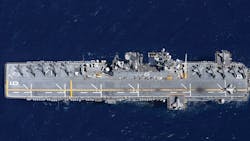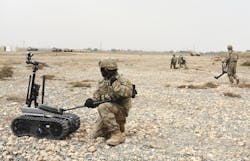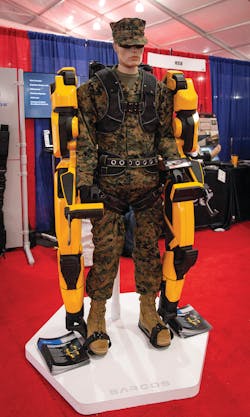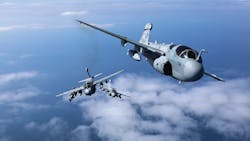The 21st century already has earned a reputation for technology revolution and evolution at speeds never before experienced. From human-like robots to self-driving vehicles to smart phones with more capabilities than top-of-the-line computers of the late 20th century, technology has become the driving force for change in society, from entertainment to health care to international relations.
A major recipient of this avalanche of change — and one of the principal drivers behind it — is the U.S. military. So what will be the top enabling technologies for the warfighter in the 2020s? Experts say the new decade will see major advances in unmanned vehicles, artificial intelligence, aircraft, maritime vessels, land vehicles, cyber security and trusted computing, medical technologies, and perhaps most notably, innovations of the newly established U.S. Space Force.
Changing landscape
The warfighter of January 2020 bears little resemblance to his or her counterpart in 2000 — or even 2015. The soldier, sailor, airman, or Marine of 2025 will be so far removed from combat uniforms to weapons to tactics, techniques, and procedures, as to be nearly unrecognizable.
In addition to pacing changes yet to come, officials of the U.S. Department of Defense (DOD) also must consider that America’s adversaries are on the same path. They are working with the same technologies freely available from commercial sources, sometimes stolen from U.S. developers, and from their own research, development, testing, and evaluation.
These new and evolving technologies impact every area of military operations, from the warfighting domains of air, land,sea, space and cyber to cross-domain components, such as communications, logistics, and intelligence, surveillance and reconnaissance (ISR). Among the most notable are unmanned vehicles like the more than 20,000 unmanned aerial vehicles (UAVs) of various types and capabilities added to DOD’s inventory since the invasion of Afghanistan in 2001.
Unmanned vehicles
From weaponized platforms the size of manned fighter aircraft to hand-launched UAVs carried by individual warfighters, UAVs have grown from a minor curiosity — originally unwanted by the military — to what has been described as the irreplaceable backbone of nearly every modern military operation. And that is true not only for the U.S., still the leader in UAV research and deployment, but for friends and foes alike, more than 100 of whom have bought or built a fast-growing global fleet of ISR and hunter-killer unmanned aircraft.
“Technological change of relevance to military innovation may be faster and more consequential in the next 20 years than it has proven to be over the last 20,” says Michael O’Hanlon, a senior fellow and director of research in the foreign policy program at the Brookings Institution in Washington.
O’Hanlon predicts in his September 2018 paper “Forecasting Change in Military Technology — 2020-2040” that robotics will be a major influence. “The dynamics in robotics and in cyber security ... may only intensify. They will likely extend in important ways into the artificial intelligence (AI) realm as well.
“At least, an examination of the last 20 years would seem to suggest the potential for such an acceleration,” O’Hanlon writes. That is particularly true since countries like China and Russia have the resources to compete with Western nations in military innovation. Some other areas of technology, perhaps most notably directed-energy systems, hypersonic missiles, and certain types of advanced materials, could play important supplemental roles in making the next two decades a true period of military revolution — or at least of very fast and ongoing rapid transformation.
Artificial intelligence
AI, at the same time one of the most controversial and most influential of all new and evolving technologies, will be at thecenter of many new and enhanced military systems. Still in its infancy in 2020, military and commercial requirements will continue to push AI development and implementation far more quickly than was forecast through the last two decades.
In 2017, Russian President Vladimir Putin predicted the nation that takes the lead in developing and implementing AI will be able to “rule the world.” While Putin appears to see AI as a development on the order of the atomic bomb, most experts liken it more to the ubiquitous growth and influence of the Internet, affecting not just the military and political power, but all aspects of human life, for good and ill.
It is an area in which the military will be pursuing its own massive research efforts as well as closely following commercial developments with potential military applications. The speed with which the precursors to true AI, such as machine learning, have evolved and been incorporated into offensive and defensive weapons and command and control systems in the past five years is predictive of what is likely to happen with early versions of artificial intelligence in the next five.
In September 2018, the Pentagon announced a five-year, $2 billion effort through the Defense Advanced Research Projects Agency (DARPA) to “develop the next wave of AI technologies.” DARPA’s Advanced Targeting and Lethality Automated System (ATLAS) program, for example, “will use artificial intelligence and machine learning to give ground-combat vehicles autonomous target capabilities.”
The military and researchers agree key to implementing AI into weapons and concepts of operation (CONOPS) is ensuring users have full confidence in the technology and what it brings to the increasingly complex, fast-paced and intensely technical combat environment.
Toward that end, DARPA is working with Lockheed Martin on the Squad X Experimentation Program, intended to give warfighters “a greater sense of confidence in their autonomous partners, as well as a better understanding of how the autonomous systems would likely act on the battlefield.”
Another DARPA program — OFFSET — being developed in collaboration with several universities and startups, is looking at the same goal as part of an effort to employ “swarms comprising upwards of 250 unmanned aircraft systems and/or unmanned ground systems to accomplish diverse missions in complex urban environments.”
AI critics often reference the “Terminator” movies as showing how full AI could become self-aware and find the human racean annoyance, if not an impediment to its own goals. This “killer robot” theme is enhanced by claims from Russia and China that they are pursuing and fielding such systems.
The United States also seeks to perfect semi-autonomous and autonomous platforms to work with human warfighters in locating and defeating enemy troops and equipment. However, the U.S. has committed never to abandon “human-in-the-loop”, where no lethal action can be taken without a human “pulling the trigger.” Neither China nor Russia has done the same.
Whatever the concerns, the U.S. and other nations are planning to develop and field AI-controlled autonomous platforms, from medical evacuation vehicles to convoys to robotic replacements for forward “first contact” human squads. A wide range of prototypes already has undergone preliminary testing and the first fully functional systems are likely to be fielded within the next five years.
The air domain
Although the fifth-generation F-35 strike fighter is just being delivered, development already is underway on a sixth-generation fighter and technologically related bomber. These aircraft will turn many activities that currently nearly overwhelm human pilots over to AI-based computers. The F-35 also is being upgraded with such systems, enabling it to become the lone manned component in a fighter group comprised primarily of UAVs.
Employing stealth technology to negate enemy air defenses, only a handful of manned fighters carrying precision-guided and AI-enhanced weapons could lead an attacking force of five or more times their number. In addition, swarms of UAVs, sometimes numbering in the hundreds, will seek to overwhelm and destroy enemy troop formations, facilities, and defenses.
Hypersonic weapons
Another technology, in which the U.S. may be lagging behind China and Russia — is hypersonics. Initially this involves missiles flying at Mach 5 or higher speeds and able to strike any point in the U.S. or its forces at sea.
This technology eventually will adapt to manned aircraft, but hypersonic missiles pose the greatest near-term threat potential. Experts say anti-missile defenses will be complicated and more complex, with only directed energy systems having the speed and agility to deal with them.
The nose cones of such missiles will be reinforced against the extreme temperatures of hypersonic flight through the atmosphere, would be immune to direct-energy weapons like high-energy lasers. Counter-hypersonic weapons, instead, must concentrate on the missile’s less-protected body as it passes over defense systems.
That would create its own set of challenges. The need to target a hypersonic missile’s vulnerable mid-body would require tracking and targeting at speeds beyond human capability — another application of AI.
Sea domain
The technologies for the next major advances in naval weaponry, communications, and operations are nearly in place. These will involve several AI-equipped unmanned platforms, directed-energy weapons, and a new approach to aircraft carriers.
Small autonomous or semi-autonomous ISR platforms sent out to extend the range of submarine or surface vessel sensors must be able to detect, identify, and target enemy assets from extremely long ranges.
Unmanned underwater vessels (UUVs), unmanned surface vessels (USVs), and UAVs, launched underwater from submarines or conventionally by surface vessels, will have the range of capabilities currently shown by advanced UAVs, such as ISR, hunter/killer, ship/sub defense, etc.
Build in a variety of sizes and with a range of capabilities, depending on how they are equipped, fleets of these platforms will be far less expensive and, due to their sheer numbers, able to cover and defend a far greater part of the world’s largest physical domain. Prototypes already are undergoing sea trials.
Using electromagnetic force to launch high-velocity projectiles accelerated along a pair of conductive rails, the railgun’s projectile is more than twice as fast as conventionally launched weapons, and can fire at ranges of 100 nautical miles.
Hitting the target at Mach 5 or higher, the projectile can inflict as much or more damage kinetically than an explosive warhead. Easier and cheaper to store projectiles, no propellant stores and range benefits would make the railgun a significant benefit to naval vessels.
Weaponized lasers, microwaves, and particle beams are moving closer to fielding as the Army, Navy, and Air Force all increase funding and research on directed-energy weapons. Programs looking into space-based systems, offensive and defense, likely will be transferred to the new Space Force.
“Directed energy, to me, is where we want to go in the long run,” Undersecretary of Defense for Research and Engineering Mike Griffin told a Capitol Hill roundtable in September 2018. “We will be pushing advances in directed energy forward for the next few years.” His statement was supported by budget requests for the U.S. Missile Defense Agency (MDA).
“Working with national laboratories and industry, MDA will address laser scaling by investing in the laser component technology required to demonstrate efficient electric lasers,” budget documents said.
The U.S. has more nuclear-powered aircraft carriers than every other nation combined. Accompanied by a battle group of submarines, destroyers, cruisers, frigates, and supply ships, each of these blue-water formations can put more firepower well within striking range of any coast on Earth than most nations can muster with their entire military capabilities.
However, carriers and their accompanying flotillas are expensive to build and maintain and offer only a dozen high level targets worldwide that are becoming increasingly vulnerable to small nuclear and electromagnetic pulse (EMP) weapons.
One increasingly popular option is a smaller “flattop” carrying vertical/short take-off and landing (V/STOL) aircraft, such as the Marine Corps F-35B, along with Marine strike forces, medevac helicopters and UAVs. Dozens of these smaller, faster, more maneuverable ships could be built and deployed, requiring far fewer personnel, for the cost of a single carrier battle group.
Land domain
The largest and arguably fastest-evolving technological arena is the land domain, where new weapons and tactics are under development — and, in some cases, already being deployed — everywhere from the individual warfighter to the Army corps. Who gets what and when depends on each recipient or group’s mission.
New and emerging technologies that are influencing equipment and operations include robotic convoys; carriers for medevac equipment, ammunition, food, and water; ISR robots; uniform-integrated medical monitoring, alert, and treatment; and individual weapons.
Robotic convoys and medevac will require few, if any, human operators, these automated transports will speed delivery and reduce casualties.
Carriers for equipment, ammunition, food, and water would be small robotic vehicles that accompany platoon and smaller units. These unmanned ground vehicles simultaneously could decrease the backpack load on individual warfighters and increase the overall supplies immediately available to the group.
ISR robots have been used for several years to search caves, check vehicles for explosives, look into buildings and show warfighters what is behind a wall or other visual barrier. Their size, range and capabilities will continue to improve with the development of new and improved technologies.
Uniform-integrated medical monitoring, alerts, and treatment involves research into capabilities to notify medics of warfighters who have sustained injuries and may not be able to call for help. It also can provide initial stabilizing injections from packets built into the warfighter’s clothing, and help update military leaders on the physical condition of troops.
Individual weapons can involve new pistols, rifles, and grenade launchers. Other land-domain enabling technologies in development include hand-launched UAVs; improved night vision; warfighter combat uniforms with lightweight body armor; precision-guided weapons; directed energy weapons; and non-lethal weapons.
Cyber domain
The newest warfighting domain, cyber, has become an integral part of all military and civilian operations. Areas in which new cyber technologies are likely to appear in the near future include tactical communications; localized cyber security; theater-level cyber warfare; and satellite based offensive and defensive cyber warfare.
Individual, squad-level, and higher communications with integrated cyber security may include real-time, helmet-mounted map and intelligence updates.
Powerful small computer chips will enable radio communications and visual displays, possibly voice-activated, mounted inside the warfighter’s helmet for hands-free use in combat. The helmet communications also could facilitate near-silent intra-squad communications that would not require hand signals.
Space domain
Efforts to demilitarize space have been only marginally effective in the last 50+ years, although orbiting weapons platforms, so far, remain verboten. However, the world’s largest and most advanced militaries are heavily dependent on satellite-based communications, navigation, timing, surveillance and guidance. As, indeed, are smaller militaries who have bought space-linked equipment.
The 2020s will see new developments in quick-launch small ISR and theater communications satellites; radiation-hardened satellites; anti-satellite offensive and defensive capabilities; and missile-defense satellites.
While several operational details remain unresolved, the basic technologies for these applications already exist. Basically, when a theater commander determines existing space assets are not in position to provide the real-time information he needs, he would order a small rocket launched from his base, carrying a sensor payload capable of giving him what he needs from a low altitude.
Medical technologies
War always has led to major advances in medicine, ranging from surgical techniques, to psychological diagnoses and treatment, to prosthetics, remote diagnoses, and even surgery.
Military medical technological advances in the near term should include regeneration; advanced materials; exoskeletons; prosthetics; artificial intelligence and virtual reality training; remote learning; and 3D printing.
Regeneration involves post-amputation approaches, and would use advanced technologies to stimulate the body to recreate the missing body part, just as a salamander can regenerate a missing tail.
Scientists have determined the regeneration gene exists in humans, but is inactive. The military has entire departments dedicated to making regeneration a reality, although successful implementation is likely many years off.
Advanced materials are being researched for fire-retardant uniforms; lighter, stronger, more flexible body armor; and lighter and stronger vehicle armor. These could reduce killed-in-action and wounded numbers below those seen by U.S. forces in Iraq and Afghanistan, which were the lowest for any military conflict in history.
Exoskeletons are wearable devices that augment human strength and endurance, and can cover the entire body or just the upper or lower extremities. These already exist, or are being considered for use in factories, loading docks, and wherever normal human strength is insufficient.
The military also is looking at exoskeletons to augment warfighter strength and endurance in combat, although considerable work remains to be done before such systems become practical.
These are only a few of the areas and technologies that are likely to continue to evolve more and more quickly in the coming decade. While most will be the natural continuations of technologies already present, even if in their earliest stages, in 2020, others will arise from research elements still in the labs or only ideas scribbled on napkins during lunch.
Just as the last two decades, spurred by the wars in Southwest Asia, growing Chinese technological prowess and a resurgent Russia, have seen great progress in military and military-adaptable commercial technologies, 2020 marks the threshold for even greater advances.






